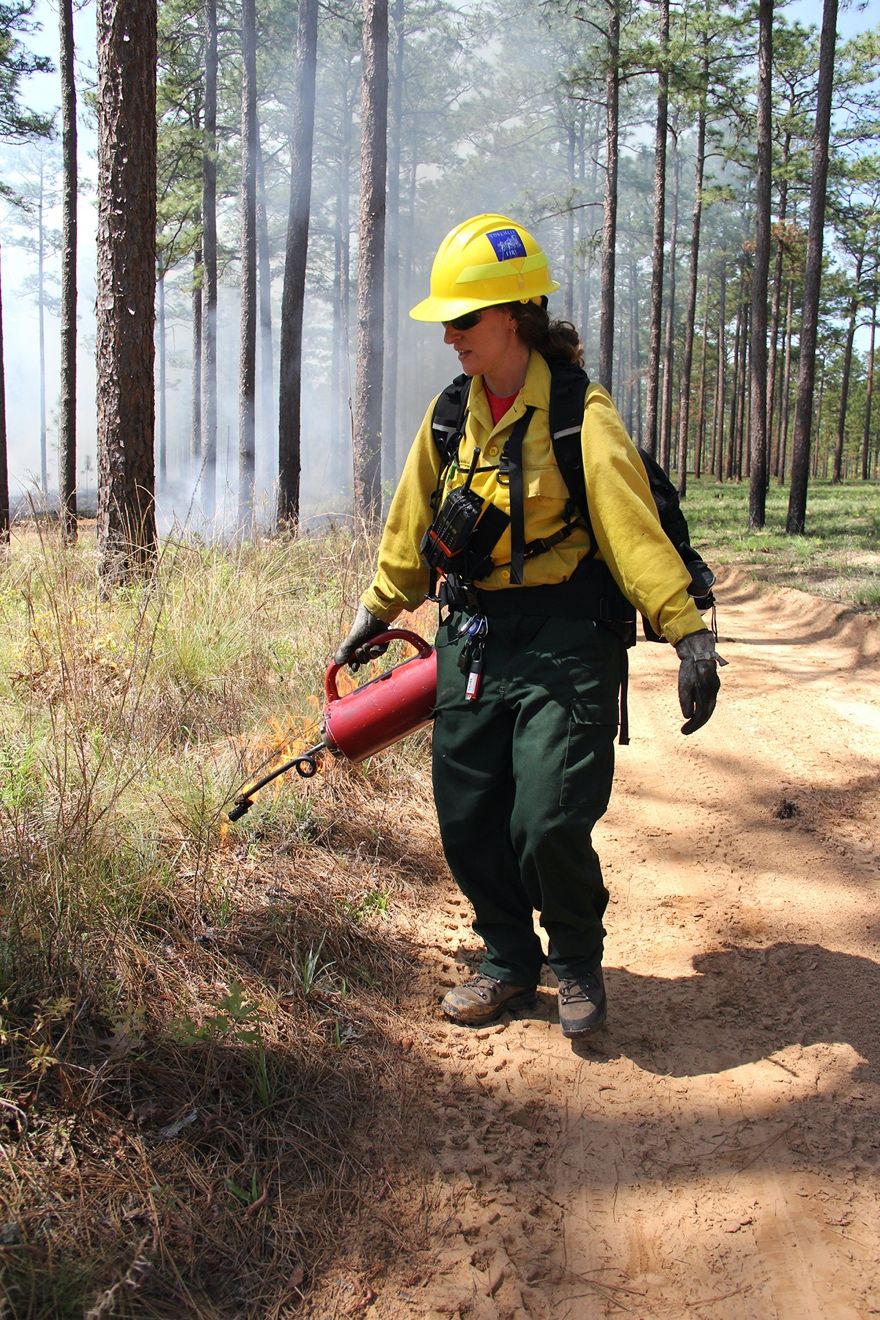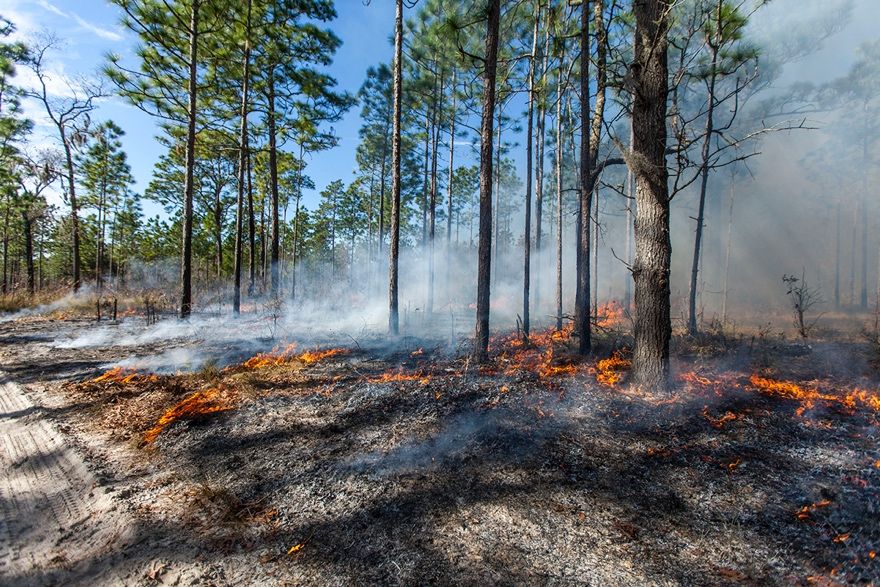Prescribed burning, the carefully planned and directed use of fire to achieve land-management goals, is a useful tool for natural resource managers in Florida. Land managers may choose fire to achieve a variety of objectives, including restoring fire-dependent ecosystems, enhancing forage for cattle, improving wildlife habitat, preparing sites for reforestation, and reducing hazardous fuel loads (Figure 1). Prescribed burns achieve many benefits for the environment and for people, but they have the potential to impact the public via smoke. Smoke is a mixture of water vapor, carbon dioxide and combustion products, including tiny particles of organic matter.

Credit: David Godwin, UF/IFAS
All fires produce smoke. Smoke production is simply unavoidable with prescribed burning, but the potential for harm can be reduced with the use of smoke-management techniques. The movement of smoke plumes can be modeled with maps or computer programs long before anyone strikes a match. This allows savvy land managers to avoid impacts on smoke-sensitive areas by burning under weather conditions that minimize smoke problems. As a result of pre-planning and careful smoke management, smoke impacts from prescribed fires are generally far less detrimental than smoke impacts from a wildfire burning over the same area.
Intended for land managers and prescribed burners, this publication provides some background information on air quality and the effects of smoke on human health and safety. The publication concludes with some strategies that can be used to protect air quality while still gleaning the benefits of prescribed burning.
Smoke and Air Quality
Air pollutants come in many varieties. Some, like carbon monoxide, are toxic to breathe and can reduce the capacity of blood to carry oxygen. Others, like carbon dioxide and methane, alter the global climate by trapping heat in the upper atmosphere. Still others, like nitrogen oxides, interact with other chemicals and sunlight to form new pollutants, such as ground-level ozone or photochemical smog. The US Environmental Protection Agency (US EPA) has established limits for six major air pollutants (ozone, particulate matter [PM], nitrogen dioxide, sulfur dioxide, carbon monoxide, and lead) based on the current understanding of health effects and environmental risks associated with these pollutants. Of the six regulated pollutants, particulate matter (PM) is the greatest concern for prescribed burners.
Particulate Matter
Particulate matter includes a variety of microscopic bits of solid matter including dust, ash, metal, and soot, that result from the incomplete combustion of organic matter. Particulates may also be liquid aerosols such as the acidic water droplets that form when sulfur dioxide mixes with water vapor. Particulates also scatter and absorb light, causing haze and reduced visibility.
Particulate matter is grouped into three categories based on size: < 2.5 micrometers (PM2.5), <10 micrometers (PM10), and total particulate matter (PM). For reference, a human hair is 70 micrometers in diameter and a grain of beach sand is approximately 90 micrometers in diameter. Particulates 10 micrometers and smaller are considered a concern for human health. Their small size makes them hard to trap in the nose and throat, so they are easily swept into the small air passages of the lungs, where they may irritate tissues and cause inflammation. PM2.5 can pass through the lungs and into the bloodstream, where evidence suggests that it can play a role in lung damage, respiratory illness, cardiovascular disease, and premature death.
As research increased and understanding of the adverse effects caused by PM grew, in 1997 the US EPA proposed strengthening the National Ambient Air Quality Standards (NAAQS) to focus more on PM2.5. The NAAQS for PM2.5 were tightened again in 2006 and 2012. National monitoring for these particulates began in 1999, and by 2013, the national 24-hour average PM concentration had decreased to approximately 2/3 of the 1999 value. In the Southeast, PM2.5 decreased by 48% between 2000 and 2019 (https://www.epa.gov/air-trends/particulate-matter-pm25-trends).
As industrial and point sources of PM have reduced emissions across the region, prescribed fires now represent a larger proportional source of PM. For this reason, federal, state, and local governments, along with other organizations, have adopted various strategies to reduce the impacts of prescribed fire smoke on the public.
Who’s most at risk?
At the population level, much of what we know about the health impacts of smoke come from epidemiological studies following prolonged wildfire events. While prescribed fire rarely results in the protracted smoke exposure associated with wildfires, certain individuals can be highly sensitive to even short-term smoke exposure. Persons with existing respiratory and pulmonary diseases are most at risk to experience the harmful impacts of smoke and poor air quality. Individuals over the age of 65 are more likely to have health conditions that put them at risk from poor air quality. About 21% of Florida’s roughly 21.5 million residents are over 65, compared to a national average of only about 16%. In some counties, 30% or more of the population is over the age of 65, which makes prescribed fire smoke management especially important in Florida.
Babies, children, pregnant women, and others with certain pre-existing conditions are also at risk to the harmful effects of smoke and poor air quality. Studies have shown that hospital visits tend to increase during prolonged periods of smoke exposure caused by wildfires. Smoke-sensitive individuals may be advised to avoid outdoor activities, use indoor HEPA air filtration systems, and wear N95-type masks to reduce their PM exposure. Individuals can assess current regional air quality conditions and forecasts through the EPA AirNow website (https://www.airnow.gov) and mobile application.
Prescribed Burning and Air Quality
Burning vegetation can result in the release of a variety of air pollutants including aerosols of organic acids and hydrocarbons and PM of various size fractions (Figure 2). The amount and composition of smoke varies with the amount of and type of fuel, its moisture content, the temperature of the fire, and the length of time materials continue to smolder after the fire. Wind speed, wind direction, mixing height, atmospheric stability, topography, landcover, time of day, and relative humidity can all influence prescribed fire smoke movement and concentration. To minimize smoke impacts to sensitive areas, before they issue prescribed burn permits, the Florida Forest Service (FFS) staff use computer models to predict smoke production and movement. Additionally, the FFS uses the EPA Air Quality Index (AQI) to determine if burn permits should be issued. During periods of existing or forecasted poor air quality, the FFS may limit burn permit authorizations. Prescribed burn managers can also conduct their own smoke modeling using several free computer-based models, including Simple Smoke Screen Tool (https://fireweather.fdacs.gov/Simple-Smoke/), VSmoke-Web (http://weather.gfc.state.ga.us/GoogleVsmoke/vsmoke-Good2.html), and PB Piedmont (https://piedmont.dri.edu/). Additional information on smoke models, model use, and air quality can be accessed through the Southern Fire Exchange (https://southernfireexchange.org) and through Certified Prescribed Burn Manager courses offered by the FFS. By using a variety of tools and practices, the FFS and prescribed burn managers can reduce the negative impacts of smoke while maintaining the practical and ecological benefits of prescribed burning.

Credit: UF/IFAS Photo by Javier Edwards
Smoke and Traffic Safety
Just as heavy rain or fog can restrict visibility for drivers, smoke from wildland fires can become a serious traffic safety concern. Florida Certified Burners undergo training to minimize the chances that prescribed fire smoke will impact sensitive areas (e.g., roadways, schools, hospitals, and airports). Sometimes, however, sudden or unanticipated changes in weather can cause smoke to shift and impact roadways and communities. Prescribed burn managers are often advised to communicate their burn plans in advance with state/local law enforcement and fire departments. All prescribed burn managers should notify authorities as soon as possible if their smoke impacts roadways or smoke-sensitive areas.
Recommendations for Prescribed Burning
Florida is a national leader in managing prescribed fire. Our unique combination of fire-dependent ecosystems and weather accommodates prescribed burning in every season of the year. Florida also has about 21.5 million residents, many of whom are sensitive to smoke. Thus, it is important for prescribed burners in Florida to manage their fires to reduce emissions whenever possible. In addition to following Florida's prescribed burning laws and guidelines, managers should consider additional preventative strategies:
- Burn the minimum amount to meet management goals.
- Delay burns until acceptable weather and fuel moisture conditions exist.
- Complete burns quickly, and extinguish smoking materials before nightfall.
- Notify neighbors of the intended burn and provide information to nearby communities on actions they can take to reduce or mitigate smoke exposure, with a particular emphasis on those individuals at-risk of smoke-related health effects.
These actions will help achieve and maintain public acceptance of prescribed fire and its accompanying smoke. Burners should consider alternative treatments to reach management objectives if air quality or smoke impacts may cause concern. Mechanical or chemical treatments may be preferable to prescribed burning in some situations.
For More Information
There are many resources available to learn more about prescribed fire smoke management, smoke movement, and smoke health impacts. Responsible prescribed burn managers are life-long learners who seek to use new tools and information to burn safely and responsibly. You can learn more about air quality and prescribed fire smoke at the following websites:
Florida Certified Burner Training and Information
Smoke and Health Information
Southern Fire Exchange Fact Sheet: Wildland Fire Smoke Effects on Public Health
https://southernfireexchange.org/wp-content/uploads/2018-2.pdf
Southern Fire Exchange Fact Sheet: Basic Smoke Management Practices for Prescribed Burning
https://southernfireexchange.org/wp-content/uploads/2014-1.pdf
US EPA Smoke Information and Tools
https://www.epa.gov/smoke-ready-toolbox-wildfires
Florida Air Quality Map
https://floridadep.gov/air/air-monitoring/content/air-quality-today
NWCG Smoke Management Guide for Prescribed Fire
https://www.nwcg.gov/publications/420-3
NWCG Smoke and Roadway Safety Guide
https://www.nwcg.gov/sites/default/files/publications/pms477.pdf
Smoke Management Information and Tools
Smoke Management Guidebook for Prescribed Burning in the Southern Region
https://bugwoodcloud.org/resource/files/18519.pdf
Florida Forest Service Smoke Screening Tool
Simple Smoke Screening Tool
http://fireweather.fdacs.gov/Simple-Smoke/
VSmoke-Web
http://weather.gfc.state.ga.us/GoogleVsmoke/vsmoke-Good2.html
PB-Piedmont
US EPA Smoke Mapping Tool